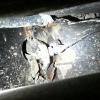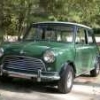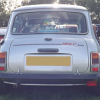
Radius Arm Reamer
#1

Posted 09 June 2011 - 09:40 PM
know the reamer size for the brass bush that comes with the radius arm kit
Thanks dave
#2

Posted 09 June 2011 - 09:44 PM
It's a long shot but are you anywhere near the Midlands? I need a couple doing.... I'd pay obviously.
Steve.
#3

Posted 10 June 2011 - 08:20 AM
#4

Posted 10 June 2011 - 11:46 AM
So what connects reaming radius arms with a lathe?
I believe that previous posts have shown the reaming operation done on a lathe. However, I would suggest using the lathe differently.
Centerdrill both ends of the reamer if it does not already have centers. Find a piece of 7/8" or so diameter round material. (I used mild steel but in actuality... you could probably use anything... steel, aluminum, nylon, Delrin). Measure the shank diameter of your 13/16" reamer and bore a 2" to 3" long piece of the round stock to just fit the reamer shank. Degrease the round stock and the reamer shank and bond the reamer and cylinder to each other. (I tack welded mine since I used steel but Loctite-680 or -271 would also work well. Even epoxy should work... at least on metal to metal. If you use plastic, make the round cylinder a press fit onto the reamer shaft instead). After the cylinder is bonded to the reamer shank, turn the assembly (ON CENTERS) at the lathe. Reduce the cylinder diameter to exactly 13/16" (0.8125").
You now have a ream with a trailing pilot. You pack the flutes of the ream with heavy grease, chuck it in an electric hand drill, and insert it through the needle bearings in your rebuilt arm. As the turned cylindrical enters the needle bearings, it will guide the reamer as you use it to cut the inside diameter of the bushing. This will keep the bushing and needle bearing concentric and sized correctly. DO NOT pull the ream out through the needle bearings. When the end of the reamer passes through the bushing, remove the reamer from the drill chuck and pass the whole reamer through the arm, extracting it through the bushing hole. This will keep chips from being deposited in the needle bearing.
The picture in the link below is my radius arm reamer.
http://home.mindspri...ArmReamer01.jpg
#5

Posted 20 August 2012 - 01:08 PM
#6

Posted 20 August 2012 - 03:46 PM
A common assumption is that it is only necessary to indicate the bushing so it is running true/concentric to the lathe chuck. The issue is that the needle bearing may not be concentric with the installed bushing and the bushing actually needs to be offset bored. That is why the stepped, piloted reamer is ideal. The pilot on the reamer is supported by the needle bearing which insures that when the bushing is reamed it is concentric to the needle bearing.
Again, while this can be done on a lather (or a mill for that matter) it is necessary to insure that the arm is properly fixtured so that boring the bushing is done concentric with the existing bore for the needle bearing.
#7

Posted 20 August 2012 - 04:46 PM
As i've noiced grease finding it's way out of the pin for the handbrake quadrat, so assume the grease tube has split. But I'm sure the bearing/bush need to come out in order for it to be changed.
I also don't want to dissemble the rear brakes and bearing unless I have to, witch is what I'd have to do if I was to fir a recon arm.
I did manage to buy a new 13/16 reamer pretty cheaply at a steam fair a while back, but it's finding someone willing to do the machining side of things for me for me to be able to use it.
#8

Posted 20 August 2012 - 05:38 PM
When the arm becomes loose the wear is usually more pronounced on the pivot shaft itself first. The bushing inside diameter wears next and there is no measurable change in the needle bearing. So fitting the new pivot shaft by itself can often remove a lot of the play or looseness in an older radius arm.
Having a split grease tube in the radius arm is not the end of the world and it is certainly a condition you can live with. With the split tube the arm will have to fill up completely with grease before any new grease is pumped into and out of the needle bearing and bushing. That will make the arm heavier as it can hold a lot of grease. However, grease is relatively inexpensive compared to the labor to replace a split grease tube. Besides, you will only fill the arm up once. In subsequent 'greasings" you will find the arm is already full of grease so it will come out of the bushing and bearing quicker (yes... along with coming out of the quadrant pivot).
If the extra grease really bothers you, I have the following suggestion. Use a slide hammer or similar to remove the needle bearing. Do not disturb the bushing. With the needle bearing removed you will be able to extract the grease tube and fit a new one. While the needle bearing and grease tube are out of the arm you can check the fit of a NEW pivot shaft in the bushing. If it is reasonably close, leave the bushing alone. Fit the new grease tube, new needle bearing, and new pivot shaft from the arm rebuild kit. The new needle bearing will have the same concentricity as the one you removed so if you leave the bushing in place it will still be concentric with the new needle bearing. No reaming will be necessary if you can re-use the old bushing and leave it in place.
#9

Posted 20 August 2012 - 05:49 PM
I tried machining an old radius arm pin once, and believe me, you do not want to go there! I was making something else, and it seemed to be a nice piece of high quality steel, but it was well-nigh impossible to machine in a lathe. Even a carbide tool was struggling.
What I observed was that it had been hardened, and the hardening went deeper than usual, maybe as much as 3mm, and was different at the bush end compared to the needle roller end. Obviously they are cylindrical ground after hardening, to exact dimensions.
Due to the hardening required, it is not viable to make or modify one of these at home, unless you know the correct process, and are able to grind afterwards. On the other hand, reaming the bush wil be easy, following Doug's method of adding the necessary guidance device to a standard reamer. You can even rotate the reamer by hand, with a suitable wrench.
#10

Posted 20 August 2012 - 05:51 PM
#11

Posted 20 August 2012 - 05:52 PM
#12

Posted 20 August 2012 - 06:03 PM
1984mini25,
I tried machining an old radius arm pin once, and believe me, you do not want to go there! I was making something else, and it seemed to be a nice piece of high quality steel, but it was well-nigh impossible to machine in a lathe. Even a carbide tool was struggling.
What I observed was that it had been hardened, and the hardening went deeper than usual, maybe as much as 3mm, and was different at the bush end compared to the needle roller end. Obviously they are cylindrical ground after hardening, to exact dimensions.
Due to the hardening required, it is not viable to make or modify one of these at home, unless you know the correct process, and are able to grind afterwards. On the other hand, reaming the bush wil be easy, following Doug's method of adding the necessary guidance device to a standard reamer. You can even rotate the reamer by hand, with a suitable wrench.
Ah, so another idea that sounds good in theory, but isn't practical.
It's not just the grease finding it's way out of the quadrat that bothers me with the greasy mess it makes. But while swapping the subframe over and fitting new pins on both arms, the arm with the split tube also had play in the bush even with the new pin. The play for now has been taken up with extra grease, but that then adds to problem of the greasy mess from the quadrat pin.
#13

Posted 20 August 2012 - 06:07 PM
The early grease tubes were metal and I managed to save one of the two that were on my car. I had to fit a plastic sleeve on one arm and it split the first time I greased the arm. I do feel your pain and frustration.
I had forgotten the homemade reamer solution Tamworthbay mentioned. I do remember that the poster said it worked very well. If you have the ability to grind flutes into a hardened pivot pin to turn it into a reamer this is certainly an option. Be careful when using this approach to not leave tall burrs on the shaft once you grind the flutes. Also keep in mind with the homemade reamer that you still have to fit the needle bearing to the arm so it will guide the reamer on center. Do not pull the reamer (homemade or purchased) back through the arm. Once it passes through the arm, un-chuck it and push it out the direction it was going so it does not drag chips back into the needle bearing.
EDIT: If the new pin is loose in the bushing there really is no substitute for fitting the new bushing and reaming to size. Sorry to hear more work is ahead.
Edited by dklawson, 20 August 2012 - 06:08 PM.
#14

Posted 20 August 2012 - 07:27 PM
#15

Posted 20 August 2012 - 07:30 PM
I don't know if I ever mentioned it here, but I did exactly as you describe way back in 1970 when, as a poor student, I could not afford a pair of reconditioned arms. I cut a couple of flutes, or maybe only one, with an angle grinder, and to turn it, welded an old wheelbrace on to the end. Thus reamed, the bushes lasted at least 50k miles! (But using the correct tools, they should last very much longer, if well lubricated.)
Oh, and I reamed the bush before changing the needle roller bearing, which meant that I did not need to do anything special to avoid contaminating the bearing. I just worked it through from the inner end, with lots of oil and effort, and unwound it the same way.
Edited by tiger99, 20 August 2012 - 07:33 PM.
1 user(s) are reading this topic
0 members, 1 guests, 0 anonymous users



















